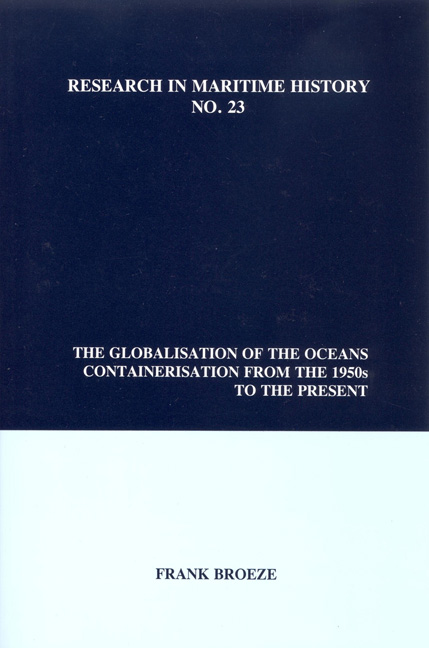Book contents
- Frontmatter
- Table of Contents
- List of Figures
- List of Tables
- Abbreviations
- Acknowledgments
- Preface
- Introduction
- Chapter 1 A Concept and its Realisation
- Chapter 2 The First Revolution
- Chapter 3 The 1970s: Conquering the World
- Chapter 4 The 1980s: Crisis and the Second Revolution
- Chapter 5 The 1990s: Globalisation
- Chapter 6 Ports, Port Systems and Liner Networks
- Chapter 7 Maritime Labour
- Chapter 8 Culture, the Environment and Recycling
- Conclusion
- Select Bibliography
Chapter 3 - The 1970s: Conquering the World
- Frontmatter
- Table of Contents
- List of Figures
- List of Tables
- Abbreviations
- Acknowledgments
- Preface
- Introduction
- Chapter 1 A Concept and its Realisation
- Chapter 2 The First Revolution
- Chapter 3 The 1970s: Conquering the World
- Chapter 4 The 1980s: Crisis and the Second Revolution
- Chapter 5 The 1990s: Globalisation
- Chapter 6 Ports, Port Systems and Liner Networks
- Chapter 7 Maritime Labour
- Chapter 8 Culture, the Environment and Recycling
- Conclusion
- Select Bibliography
Summary
The towering containership, with its slab-sided building blocks of cargo and dramatically flared bow, is ubiquitous and commonplace today.
By the late 1970s, containerisation had become a worldwide system. From its foundations in the trades between the industrialised and wealthy poles of the global economy, the revolution had spread like a nuclear chain reaction across the world, sweeping all before it. The degree to which liner cargoes could be containerised had surpassed all expectations, as that European veteran of containerisation, Karl-Heinz Sager, recalled in 1981:
I still remember how piles of cargo manifests for certain trades were analysed at our [i.e., North German Lloyd] offices, in order to establish which goods could reasonably be packed in containers. At the time we arrived at a proportion of only about 25-30 per cent for the North Atlantic, though today [i.e., 1981] 80-90 per cent of all cargo there is carried in containers. For the US/Far East trade our calculations were only slightly more encouraging.
A survey instigated by the Far Eastern Freight Conference in 1978 found an even more complete transformation in its field: of all Europe/East Asian cargoes, eighty-three percent was already containerised; of the trade between East Asia and Europe, ninety-two percent was; while ninety-nine percent of the trade from Europe to Japan was carried in boxes. But it was not just the rapid growth and intensification of containerisation on the main routes that amazed experts and propelled the industry forward. It was also the extent to which containerisation (including, to a much lesser extent, RoRo) invaded the trade with the less- developed areas of the global economy - what, adopting the economicideological imagery of the Club of Rome, became known as the North-South trades. While many insiders had believed that the industry would take a breather after the containerisation of the Europe-Singapore-East Asia route, the second stage followed almost without interruption (see table 2).
The capacity of the world container fleet between 1973 and 1983 grew from 278,000 to almost 2,000,000 TEUs, an increase of approx. 620 percent. (Its effective productivity rise was somewhat lower, as the excessive and costly service speeds of the early- and mid-1970s were reduced to more modest levels.) With the exception of 1974-1976 annual growth rates of twenty percent and more were common.
- Type
- Chapter
- Information
- The Globalisation of the OceansContainerisation from the 1950s to the Present, pp. 51 - 78Publisher: Liverpool University PressPrint publication year: 2000



